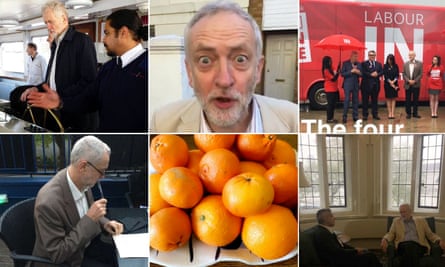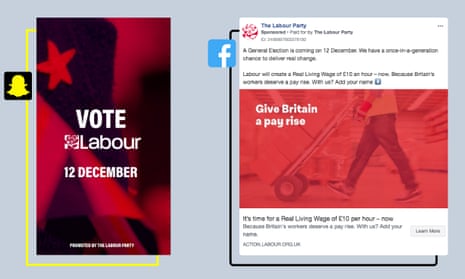Labour is vastly outspending the Conservatives on Snapchat, as the two parties compete to present their message to millions of young voters through the social network.
Spending just £3,000 on the platform, the Tory party has been pushing its “get Brexit done” message to the app’s audience, who are overwhelmingly under 30.
The advertising, which focuses heavily on Boris Johnson, is targeted at all users over 18 – but is hidden from viewers in Scotland and Northern Ireland, as well as from Johnson’s own constituents in Uxbridge. The “Back Boris” messaging could be counted against constituency spending limits if it were not excluded.
Labour has spent almost five times as much, nearly £15,000, pushing two adverts. The first, accounting for £10,000 of spending in the opening week of the campaign, was a simple message with the slogan: “Time for real change: Vote Labour.” More recently, in a campaign ending on Tuesday, Labour has more explicitly campaigned on Brexit, offering a riposte to the Tory strategy, claiming: “Only Labour will give people the final say on Brexit.”

Both parties have received extraordinarily good value for money on their advertising. Labour’s spend has bought almost 13m video views, while the Conservatives have had more than 2m. That means the parties spent around £1.20 for 1,000 views of their video adverts. On Facebook, by comparison, Labour spent at least £16 for 1,000 views of one of its recent adverts.
Both party leaders also have profiles on the social network. Jeremy Corbyn has been active since 2016, when his Snapchat account – the first of a UK party leader – made headlines. This time round, however, the campaigning on Snapchat is more subdued: the stories format is more popular on Instagram, where Corbyn’s team continues to post, while Boris Johnson’s account hasn’t posted since the Conservative party conference.
No other major UK party has a significant presence on Snapchat. The second highest political ad spend on the platform isn’t a party at all, but the non-partisan campaign group Vote For Your Future, which has spent more than £10,000 on 16 adverts encouraging young people to vote.
It will be the first UK election since Snapchat started publishing all political adverts posted to its platform, but the social network has already been accused of providing bad data to researchers. In the first version of its political advertising library, the social network accidentally claimed that the Conservatives were only advertising in Uxbridge – rather than excluding all their adverts from Uxbridge, as is actually the case.

The campaign group Who Targets Me reported the spend as evidence that the Conservatives were worried about losing Johnson’s seat, and the claim was picked up by other media groups. Following inquiries from the Guardian, Snapchat acknowledged a bug in how it had prepared the information, and updated a fixed version of the sheet. The bug had apparently been unnoticed since mid-September, when Snapchat launched the feature in a blaze of publicity.
Who Targets Me was critical of the company’s error. “With political parties spending more and more on online ads, and election outcomes increasingly influenced by digital tactics, it’s critical that accurate, timely information on who is spending what is made publicly available,” said Sam Jeffers, the group’s co-founder, when the Guardian flagged the mistake.
“As a small organisation working to increase ad transparency during elections, we expect big companies, with large resources, to play their part. This includes checking that the data they release is accurate.
“Until the standards for political ad transparency are mandated in law, with suitable penalties for non-compliance exist, mistakes will continue to happen. We will keep working to hold social media companies and the political parties that advertise on them to account, to ensure our elections are as transparent as possible. We all have a right to know how we are being targeted online.”
